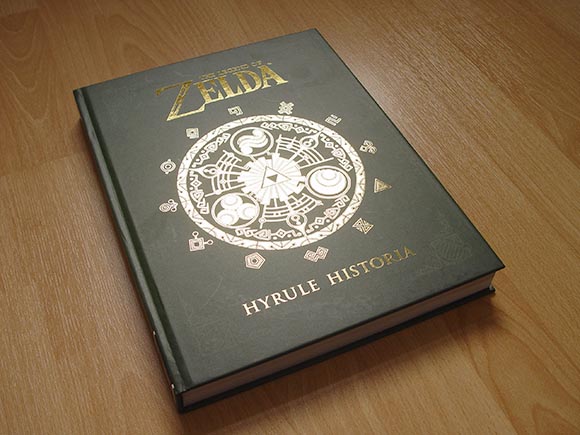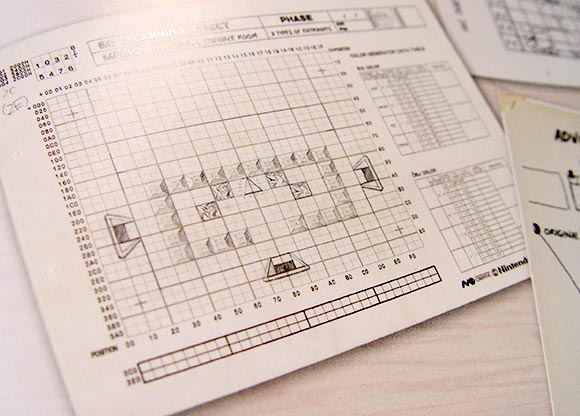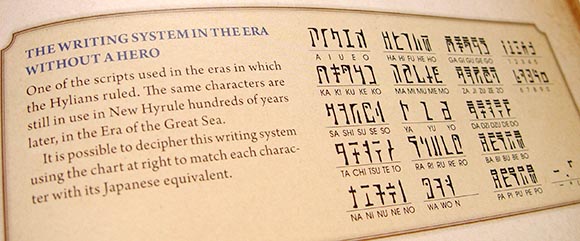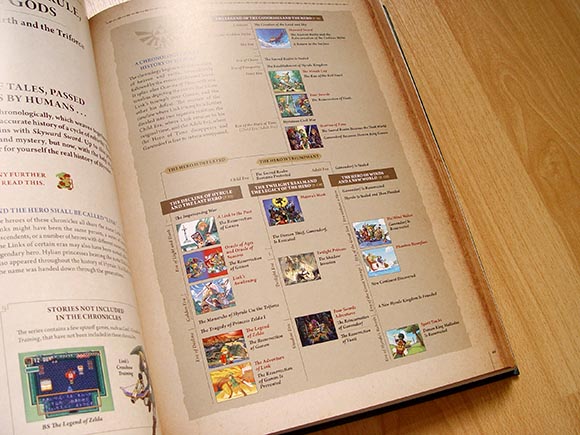Here is an interesting game thing to get. Nintendo recently released a book called Hyrule Historia in the west.

Around 250 pages. A4 Format. Full-color. Hard-bound with golden print on the cover.
The books is somewhat unusual. On first sight one could call it an artbook for the Zelda series. The main bulk of the content does focus on character and environment art. Needless to say, the artwork is quite stunning.

Most of the pages show character and environment artwork. Mainly from Skyward Sword.
As always, I find myself drawn to the concept art more than to finished results. At various points the book shows variations that were considered during development process.

There are some character design sketches every now and then.
One unusual feature is that the book attempts to cover ALL of the Zelda games. Indeed there are chapters dedicated to the various games. However, there is an obvious focus on the most recent installment, Skyward Sword. Because I haven’t played it yet, most of the depicted characters and creatures are insignificant to me. Sadly, the Zelda part that interest me the most – A Link to the Past – received a laughably minor treatment. It’s basically just one page with a few images of Link.

The book contains some game design documents. They are rare and appear only as very small thumbnails. But they are fully translated.
Besides the artwork, there is some actual behind-the-scenes / game design material as well. Every now and then there are scans of game design documents and notes. Suprisinglly, all of the hand-written text on those scans has been replaced. This sacrifices the authenticity for comprehension. I do enjoy the result. My only problem is that this kind of content is just too scarce. There are just a few pages scanned in total. They usually appear as tiny thumbnails together on one page. I would have loved to see an entire chapter dedicated to those.

Zelda fans get the Rosetta stones to be able to read ancient runes in the games.
A big deal for Zelda fans are probably the translations of various alphabets from the different games. Using those Rosetta Stones, one is able to read the ancient Engraving and Scrolls. I’m surprised that the devs went the length to actually design a translatable alphabet. I wonder if the translated texts are actually readable in a real language or if they result in random gibberish.

The key stone of the book – the 1st official Zelda timeline.
The key stone of the book is the first official Zelda timeline. A mind-boggling attempt to sting all of the various Zelda games into one, big, overarching story. Personally, I always found the story of the Zelda games quite tired and stereotypical. The attempt to weave them together into one big epic is adorable. But it is a disingenuous gesture to present this side-by-side with behind-the-scenes material. The individual episodes don’t seem to have been designed with a meta-narrative in mind, yet the book implies that they were.
It is an odd book. It seems to evoke the idea of giving a glimpse behind the scenes. But it does so in a very reserved, controlled and dumbed-down fashion. It never quite commits to exposing Zelda series as the artificial, designed product. It gives us as small peek and pulls the veil close again and distracts by extending the game’s in-game narrative even more. It’s fan-fiction made by the original authors – authentic and opulent. But at the same time condescending, pandering and masturbatory.
If you have been playing games in the 80ies and 90ies, chances are you have some interest in the Zelda series. In spite of the above, I recommend Hyrule Historia. At around 250 hard-bound, full-color pages for just 25 EUR it is at least quite a bargain for a weirdly dissonant and certainly pretty experience.






>I’m surprised that the devs went the length to actually design a translatable alphabet. I wonder if the translated texts are actually readable in a real language or if they result in random gibberish.
For Skyward Sword at least, the ingame runes are certainly readable. It’s English (at least, the US version is–and I doubt they’d change these textures per region) with funky glyphs.
Similarly, the characters in the “Rosetta Stone” example you photographed above are just somewhat stylized forms of their katakana equivalents (neatly avoiding hiragana or kanji: katakana is always used for writing words of foreign or invented origin – including fictional names, places etc. – and can sometimes used for ordinary Japanese as well, especially on signs). The Japanese audience probably wouldn’t have much difficulty in interpreting it without a guide.